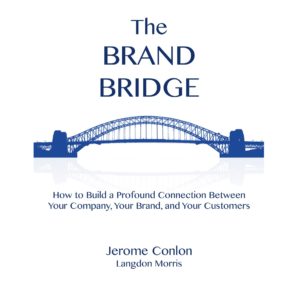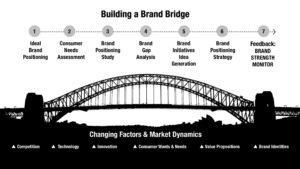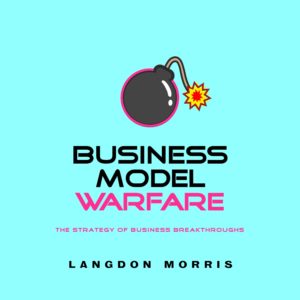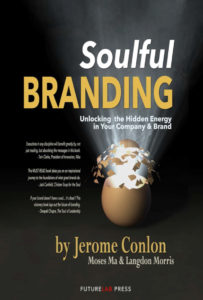
Storytelling
Before we get to the branding question, first a quick note to let you know that our friend, colleague, and super-scribe Christopher Fuller is sharing very cool insights on his awesome web site, The Griot’s Eye, and the stories he tells there are compelling and definitely worth taking in. Here’s a fine example:
Branding
And now about that branding thing …
What are the most valuable brands in the world, and what are they worth? According to Forbes, the world’s 100 most valuable brands have a collective value of $2.3 trillion, of which the top five, Apple, Google, Microsoft, Amazon, and Facebook, are worth a combined $682 billion. Apple is the most valuable of all, at $205 billion.
These are big, gigantic numbers, and they say a lot about the importance of branding and brand building.
Which is timely for us, because our latest book has just been released and it’s all about brands and branding.
Written by Jerome Conlon, one of the world’s most respected branding gurus, and co-authored by InnovationLabs’ Langdon Morris, the book goes into unprecedented detail about two of the world’s most iconic brands, Nike and Starbucks, and tells never-before-been-told stories of how they ascended to the brand pantheon.
How is Jerome qualified to write about those brands? Simple. He was there on the front lines, helping build both brands, and telling the story in super detail in this book. During his years at Nike, the company grew from $400 million in annual sales to more than $6 billion, and he tells the engrossing story of the Air Jordan phenomenon, and of the origins of the “Just Do It” advertising campaign, which helped propel the company to new and greater heights. An Excerpt
An Excerpt
Each brand strives to be unique, and thus as there are many different kinds of companies, there are many different kinds of brands. At the highest level, though, a brand is one thing and one thing only – an overriding expectation that over time takes on a basic set of product or service performance associations.
People who use the product/brand regularly come to expect and trust that the next time they buy it, they’ll have an experience that’s in line with their expectations, and on this level a brand is a promise that describes a set of past experiences and future expectations in the minds of customers.
Effective brands therefore become powerful symbols, marks of distinction, discernment, expressions of status, good taste, youthfulness or other desirable attributes. Such symbolic brands are significant players in high-interest, high-involvement categories, and they make careful use of mass media and digital media to keep their brand stories buzzing. These brands, that is, don’t come into being by accident, but because someone took the time to build, enhance, and maintain the essential bridge.
Inherent in any brand is its product promise, what it does. But the strongest brands are both complex and symbolic, and they go far beyond a product-only relationship. They transcend their material qualities to develop an image and a voice that’s often human-like in character; they become “people” because we project character upon them, which of course strengthens their unique standing in the marketplace.
Traditional marketing theory used to hold that products have value, and the image of a product reflected this value. In other words, a car was considered as a means of transportation, a telephone a device to communicate, and a computer a tool to store, retrieve, and process data. Marketing these products was based on their physical qualities and attributes, and their ability to satisfy particular needs. Companies strived to detect consumer needs and develop products and services to satisfy them.
Thus, the orientation of marketers was to the object, the good or service, but less so to the subject, human being. Consumer satisfaction was understood to result from material elements contained in the product. The ideas and images put forth in marketing simply represented the material aspects, the physical attributes of the product.
Pick up your copy now at Amazon.
Today’s marketers consider much more. Now the ideal brand image is the primary consideration, and the product is one variable that represents but one facet of the brand’s total image as a function of the relationship between object (the product) and subject (the customer).

The Overall Brand Building framework, one of about 80 figures in the book.
Reviews
Early reviews have been exceptionally positive. Here are a few examples:
Soulful Branding provided deep insights into the emotional underpinnings of great, enduring brands. The Brand Bridge takes us further, to explain exactly how the greatest brands were created and are sustained over time.
Doug Glen, former Chief Strategy Officer of Mattel Toys; Chief Executive of Imagi Studios; General Manager of Lucas Arts Entertainment, and Group Vice President of Sega of America
With his renowned talents in branding and marketing, Jerome Conlon has combined with innovation guru Langdon Morris to craft a book that is as inspiring and forward-thinking as it is practical and down-to-earth. Based on a wealth of experience and deep insights from Nike, Starbucks and other top companies, The Brand Bridge is a thorough, step-by-step guide for developing powerful business models and brands that achieve enduring marketplace success.
Kevin Lane Keller, E.B. Osborn Professor of Marketing, Tuck School of Business, Dartmouth CollegeThe Brand Bridge takes me back the Boston Deli on the Nike Campus, into a second round of Mind Sweepers (a highly caffeinated coffee), trying to isolate the strands of DNA that were truly global and could work anywhere — the highest emotional denominators across age, sex, culture, religion, fitness level, etc. I honestly don’t believe very many people at Nike appreciated what we did there. But it didn’t matter. It was always about the brand, never us.
Scott Bedbury, Author of It’s A New Brand World, Former Global Advertising Director, Nike, Former Chief Marketing Officer of Starbucks
Pick up your copy now at Amazon.
The Trilogy
The Brand Bridge is the third volume in a trilogy consisting of Jerome’s first book, Soulful Branding, and Langdon’s book Business Model Warfare. Taken together, the three of them provide a deep level of strategic guidance to innovators, marketers, and senior leaders who understand the power of today’s changes, and are committed to attaining or maintaining leadership in the complex marketplace.
As always, we welcome your feedback!
Sydney Harbor Bridge: Image by Martin Str from Pixabay
https://pixabay.com/photos/harbour-bridge-sydney-night-bridge-225567/




